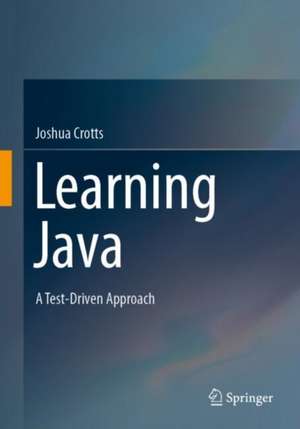Learning Java: A Test-Driven Approach
Autor Joshua Crottsen Limba Engleză Paperback – 28 sep 2024
This ordering of topics is well adjusted to prepare students to subsequent upper-level courses in data structure or algorithm design and implementation. The approach is illuminated by numerous code snippets and the students’ understanding is consolidated by about 250 exercises covering all topics covered in the book. With this book, readers will not only learn how to program Java, but also acquire a necessary precondition for successfully writing and testing commercial software.
Preț: 472.45 lei
Nou
Puncte Express: 709
Preț estimativ în valută:
90.43€ • 98.26$ • 76.01£
90.43€ • 98.26$ • 76.01£
Carte tipărită la comandă
Livrare economică 21 aprilie-05 mai
Preluare comenzi: 021 569.72.76
Specificații
ISBN-13: 9783031666377
ISBN-10: 3031666372
Ilustrații: X, 460 p. 41 illus., 31 illus. in color.
Dimensiuni: 178 x 254 mm
Greutate: 0.84 kg
Ediția:2025
Editura: Springer Nature Switzerland
Colecția Springer
Locul publicării:Cham, Switzerland
ISBN-10: 3031666372
Ilustrații: X, 460 p. 41 illus., 31 illus. in color.
Dimensiuni: 178 x 254 mm
Greutate: 0.84 kg
Ediția:2025
Editura: Springer Nature Switzerland
Colecția Springer
Locul publicării:Cham, Switzerland
Cuprins
Part I: Java Programming and Data Structures.- 1. Testing and Java Basics.- 2. Conditionals, Recursion, and Loops.- 3. Arrays, Collections, and Generics.- Part II: Objects, Classes, Exceptions, and I/O.- 4. Object-Oriented Programming.- 5. Exceptions & Data I/O.- Part III: Searching, Sorting, and Algorithms.- 6. Searching & Sorting.- 7. Algorithm Analysis.- 8. Modern Java and Advanced Topics.
Notă biografică
Joshua Crotts is a computer science Ph.D. student at Indiana University with a strong interest in computer science pedagogy, as well as programming languages and compilers. He has published papers at conferences like SIGCSE, CMNA, ICEEL about formal logic education, automatic detection of rhetorical devices (e.g., antithesis), and inductive logic programming as a means of argument mining in science-policy articles. His current research work aims to improve the transition of first-semester students to the later advanced topics and courses.
Textul de pe ultima copertă
This introductory textbook on Java programming is different from others by its emphasis on test-driven development. Writing tests before designing the implementation is incredibly important for debugging purposes and understanding the desired outcome. While testing is often an afterthought in other Java textbooks (being placed at the very end or not at all, which is in some ways cruel to withhold such capabilities from the student), this text takes a different, perhaps "functional" approach to learning Java: it introduces testing and methods from the start, followed by conditionals, recursion, and loops (on purpose in this very order). It then dives deep into data structures and the Java Collections API, including streams and generics. After this, it pivots to object-oriented programming, exceptions and I/O, searching and sorting, algorithm analysis, and eventually advanced Java/programming topics.
This ordering of topics is well adjusted to prepare students to subsequent upper-level courses in data structure or algorithm design and implementation. The approach is illuminated by numerous code snippets and the students’ understanding is consolidated by about 250 exercises covering all topics covered in the book. With this book, readers will not only learn how to program Java, but also acquire a necessary precondition for successfully writing and testing commercial software.
This ordering of topics is well adjusted to prepare students to subsequent upper-level courses in data structure or algorithm design and implementation. The approach is illuminated by numerous code snippets and the students’ understanding is consolidated by about 250 exercises covering all topics covered in the book. With this book, readers will not only learn how to program Java, but also acquire a necessary precondition for successfully writing and testing commercial software.
Caracteristici
Introduces the basics of Java from simple commands to object-oriented programming and exception handling Emphasizes test-driven development by integrating test case design and implementation in the design process Includes numerous case snippets and examples as well as about 250 exercises on all topics covered
